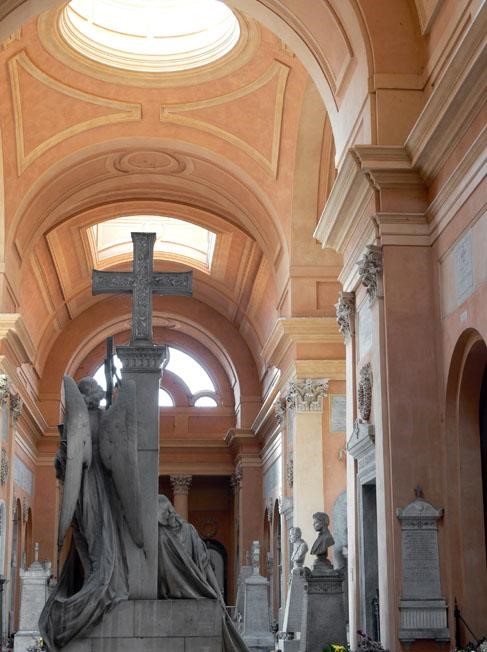Angel Gallery - Seventh Cloister -Three Naves Gallery
Coriolano Monti (Perugia, 1815 – Perugia, 1880) built the elaborate, grandiose Three Naves Gallery in Certosa in 1863. Its central nave is covered with barrel vaulting and the two side naves have a flat ceiling and an imposing transept which is also tripartite: there is a large hemispherical dome where the nave meets the transept. The neoclassical architecture combines Roman references with references to Adam, the Louvre Grand Gallery and the Vatican Museums New Wing, but Piranesi’s influence is present in the tight play of contrasts between light and shadow.
Additional work was done one decade later by Antonio Zannoni (Faenza, 1833 - Bologna, 1910), who had become chief engineer at the Certosa technical department, with designs realised in the 1870s and 1880s for the Angel Gallery and Seventh Cloister, thus connecting the 19th century halls to the Third Cloister, the original Large Cloister of the monastery. A comprehensive repertory of 19th and 20th century Bolognese sculpture can be seen in the area and in these architectures. We make mention of only a few of the most significant monuments, such as those by Stefano Galletti (Bolognini Amorini, 1864), Salvino Salvini (Beau, 1874), Carlo Monari (Enea Cocchi, 1867), Diego Sarti (Montanari, 1891), Enrico Barberi (Bisteghi, 1891), Tullo Golfarelli (Simoli, approx. 1905), and Pietro Veronesi (Berselli, 1902).
The monuments to the ceramist Angelo Minghetti (1822-1885) and the publisher Nicola Zanichelli (1819-1884) have historical importance and are both significant works by Alessandro Massarenti. Salvino Salvini is credited with designing the monument to the orthopaedist Francesco Rizzoli (1809-1880).
The Seventh Cloister contains the Marconi family tomb (south portico, burial recess 118), where alongside his father Giuseppe, was buried the Nobel prize-winner Guglielmo (1874-1937) while awaiting completion of the mausoleum at Villa Griffone in Sasso Marconi.

Coriolano Monti (Perugia, 1815 – Perugia, 1880) built the elaborate, grandiose Three Naves Gallery in Certosa in 1863. Its central nave is covered with barrel vaulting and the two side naves have a flat ceiling and an imposing transept which is also tripartite: there is a large hemispherical dome where the nave meets the transept. The neoclassical architecture combines Roman references with references to Adam, the Louvre Grand Gallery and the Vatican Museums New Wing, but Piranesi’s influence is present in the tight play of contrasts between light and shadow.
Additional work was done one decade later by Antonio Zannoni (Faenza, 1833 - Bologna, 1910), who had become chief engineer at the Certosa technical department, with designs realised in the 1870s and 1880s for the Angel Gallery and Seventh Cloister, thus connecting the 19th century halls to the Third Cloister, the original Large Cloister of the monastery. A comprehensive repertory of 19th and 20th century Bolognese sculpture can be seen in the area and in these architectures. We make mention of only a few of the most significant monuments, such as those by Stefano Galletti (Bolognini Amorini, 1864), Salvino Salvini (Beau, 1874), Carlo Monari (Enea Cocchi, 1867), Diego Sarti (Montanari, 1891), Enrico Barberi (Bisteghi, 1891), Tullo Golfarelli (Simoli, approx. 1905), and Pietro Veronesi (Berselli, 1902).
The monuments to the ceramist Angelo Minghetti (1822-1885) and the publisher Nicola Zanichelli (1819-1884) have historical importance and are both significant works by Alessandro Massarenti. Salvino Salvini is credited with designing the monument to the orthopaedist Francesco Rizzoli (1809-1880).
The Seventh Cloister contains the Marconi family tomb (south portico, burial recess 118), where alongside his father Giuseppe, was buried the Nobel prize-winner Guglielmo (1874-1937) while awaiting completion of the mausoleum at Villa Griffone in Sasso Marconi.
20